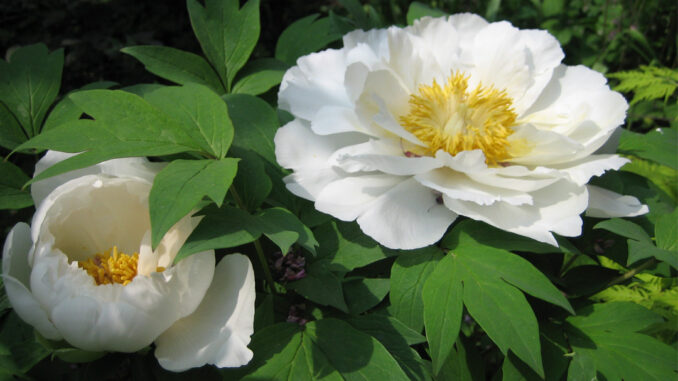
With eager plans for trips coming up, there’s still an opportunity to address gardening problems that are best solved in autumn. Don’t we all want more and better peonies? And how about giving the lawn what it needs in the cool days ahead.
Making the best of autumn days for effective problem-solving.
Peony problems solved in autumn
Autumn is the best time to address issues concerning peonies, when their leaves are beginning to turn yellow and the plants are semi-dormant. This is the ideal opportunity to move or divide peonies, or to simply adjust root circumstances in the current hole and re-settle the root ball. The requirements for healthy peonies are simple – adequate sunlight, sufficient air circulation and shallow depth of their roots. These are the factors to consider when mature peony plants fail to bloom.
Among the most romantic of flowering perennials, peonies are anticipated in mid-June, when they deliver a generous number of large, multi-petal blossoms. These heavy, bombshell-style flowers last for about three weeks and are best displayed individually staked to thin bamboo canes with their heavy heads supported. When the flowers are finished, cut off the forming seed pods and let the remaining thick stands of green leaves continue manufacturing energy for the next year of bloom.
Young peony plants may not bloom in the first year after planting and might need more time (another year or two) to establish a sufficiently large root mass. More mature plants can be purchased in bloom or with flower buds, demonstrating their readiness to perform in the garden. They require a minimum of four hours of direct sunlight; less sun exposure will result in fewer flowers. If peonies are planted in light shade, there may be no flowers at all.
Air circulation is crucial for healthy peony plants. If their planting location is densely packed with neighbouring plants or the location is enclosed by walls or trellis structures, disease conditions can prevent peony buds from maturing. Botrytis is a fungal disease prevalent in cool, wet spring weather. Without consistent air movement surrounding peony clumps in May, the flower buds can be infected and mummified before maturing. To avoid this potential problem, always select an open location for peonies where air current is constantly moving.
Peonies grow best in cold regions and, with sufficient chilling, have long garden lives producing strong root balls and many flower buds. When set too deeply into their holes, peonies may be deprived of the necessary chilling temperature and will fail to produce flower buds in spring. Mature peony plants have sizeable root balls with irregular shapes and it’s difficult to estimate just how deep or shallow to set the root mass. An easy way to know whether the peony is set just right (and not buried too deep) is to check for the pink buds that should be present at the top of the plant crown in autumn. These autumn buds are for next year’s growth and should be no deeper than two inches under the soil. On established plants, look for the buds even at surface level, indicating that they’re set just right to perform next spring.
With attention to adequate sunlight, air circulation and appropriate planting depth, peonies should present you with luxurious blooms in June. And don’t be worried about the presence of ants on spring peony buds – they’re doing their job. Peonies excrete sticky nectar over their buds that is very attractive to ants. The ants will clean the nectar away and allow the buds to open. (The nectar possibly prevents buds from opening when vulnerable to frost, before ant activity.) If you cut flowers for a vase, hold them upside down and shake any ants off outdoors. Set the vase with water and flowers in a sink for an hour and allow remaining visitors to make an escape.
Last and best chance to improve the lawn
The cooler night temperatures of autumn are consistently reliable for repairing lawns damaged by summer heat and drought. Seeds of northern lawn grasses grow best when night temperatures are between 10C (50F) and 18C (65F). Erratic spring weather can unexpectedly exceed that temperature range, jeopardizing grass-seed planting.
Most commercial lawn-seed mixes contain three or more varieties. Each grass variety contributes specific characteristics, such as quick germination and tolerance to foot traffic (perennial rye grass), deep blue-green colour (Kentucky bluegrass) and shade tolerance (fine fescue). The most drought-resistant lawn plant – white clover – is left out of the lawn-grass mixes and must be purchased and added by gardeners who are hoping to improve their lawns.
The benefits of white clover are that it will not go dormant or brown in summer drought, and that it can collect nitrogen from the air and distribute it underground from root nodules, feeding both itself and lawn grasses. Adequate amounts of white clover mixed into lawn grasses will provide approximately one-third of the required seasonal nitrogen.
Grass-seed mixes are useful for repairing lawns with bare spots, or thin turf that has permanent damage due to extreme summer conditions. The large-print information on the front of lawn-seed packages tells the best purpose for the seed mix, such as sunny locations and partial or full shade. The small print on the back of the package identifies the specific grass seeds and their percentage in the mix. These individual seed strains can be purchased from seed companies when a gardener wants to make a custom mix or address one specific problem; for instance, a thin lawn in shade (fescue seeds) or a lawn damaged by foot traffic and athletic use (perennial rye grass seeds).
To improve a damaged lawn in autumn, rake leaves off of the turf and use a simple hand-held seed broadcaster to distribute the seed. Best germination results from using a soft leaf rake to spread peat moss over the treated areas. The peat moss will help to keep a moist environment around the seeds and protect them from daylight wind exposure. Sprinkle seeded areas with water each day for two weeks.
White clover is often sold in small bags alongside grass-seed mixes, or it can be purchased online from seed companies. It germinates best in cool and moist conditions with chilly nights. There are several strains of clover, but only white clover (Trifolium repens) is suitable for lawn use. When broadcast onto an established lawn, white clover will thicken the turf but, in northern climates, it doesn’t have enough resilience to be invasive. Winter frost always takes a toll on a percentage of white clover on a lawn, although enough survives to be useful and it can be seeded repeatedly as needed. The seeds of white clover are quick germinating – usually within seven to 10 days – and do not require covering when broadcast onto the lawn.


